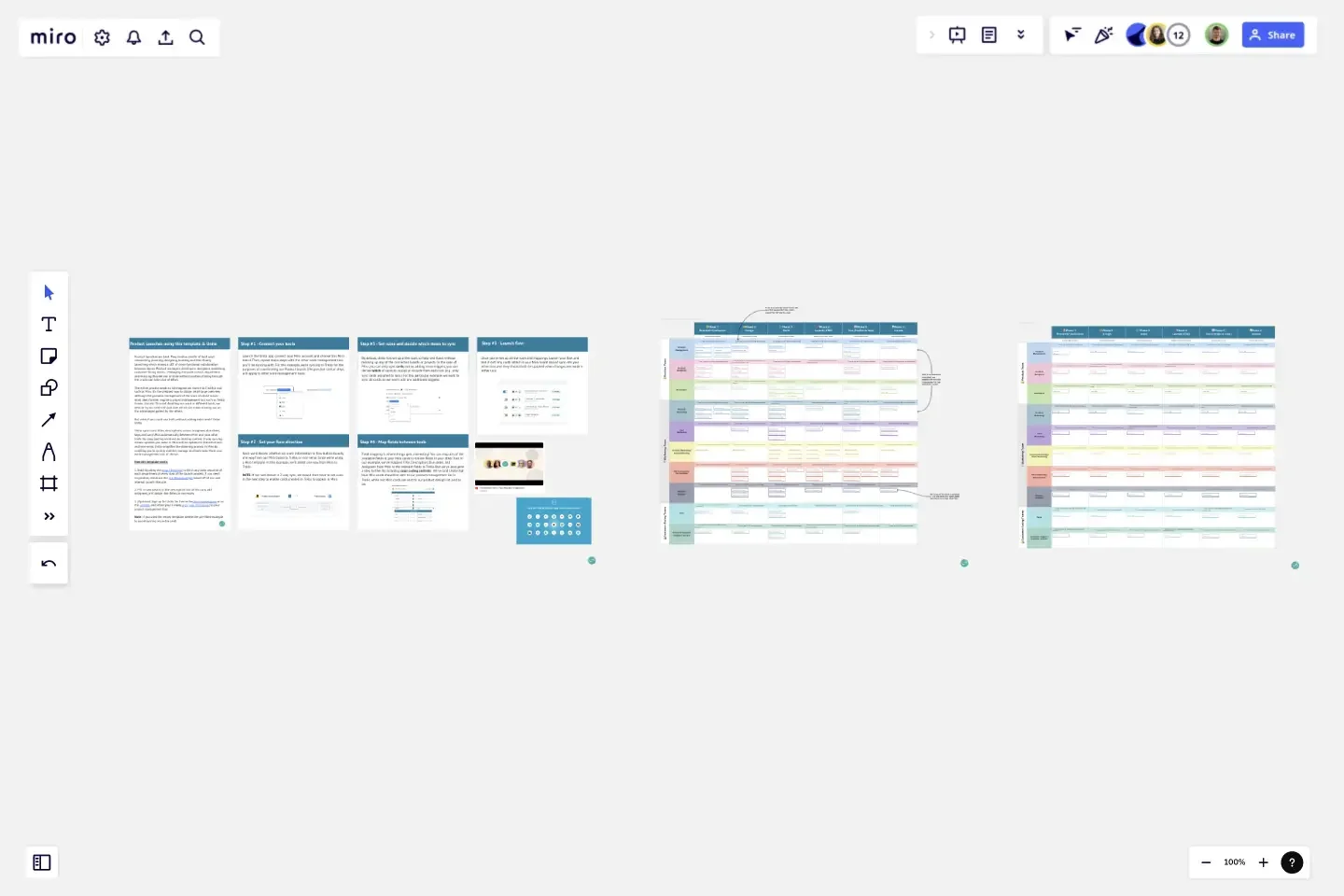Product Launch Lifecycle
Product launches are hard. They involve months of hard work researching, planning, designing, building and then finally launching, which means a LOT of cross-functional collaboration between teams.
Product managers, developers, designers, marketing, customer-facing teams... Managing everyone in each department and ensuring they deliver on time without anything falling through the cracks can take a lot of effort.
This template, combined with Unito, is built to help you deliver on even the biggest an most complex product launches.
How this template works:
1. Start by using the empty template to fill in any tasks required of each department at every step of the launch process. If you need inspiration, check out the pre-filled example based off of our own internal launch lifecycle.
2. Fill in task details in the description box of the card, add assignees, and assign due dates, as necessary.
3. (Optional) Sign up for Unito for free in the Miro marketplace or on the website, and when you're ready, sync your Miro board to your project management tool.
Note: If you used the empty template, delete the pre-filled example to avoid syncing any extra cards.
This template was created by Unito.
Get started with this template right now.
Corrective Action Plan Template
Works best for:
Project Management, Operations, Strategic Planning
For a manager or HR leader, it’s the least fun part of the job: Documenting an employee’s performance issues and talking about them directly to that employee. A corrective action plan makes that tough task a little easier by putting issues into a professional, written framework. That way the process, next steps, and details of the conversations are all clearly documented. This template will enable you to eliminate murky communication, align on expectations, and provide step-by-step instructions for your employee.
Agile Product Roadmap
Works best for:
Roadmap, Planning, Mapping
The Agile Product Roadmap template enables teams to visualize and communicate the strategic direction of their product development in an agile environment. It allows for flexibility and adaptation to changing requirements while providing a clear overview of priorities and timelines. By incorporating feedback loops and iterative planning, teams can ensure alignment with stakeholder expectations and deliver value incrementally.
Jobs to be Done template
Works best for:
Ideation, Design Thinking, Brainstorming
It’s all about a job done right — customers “hire” a product or service to do a “job,” and if it's not done right, the customer will find someone to do it better. Built on that simple premise, the Jobs To Be Done (JTBD) framework helps entrepreneurs, start-ups, and business managers define who their customer is and see unmet needs in the market. A standard job story lets you see things from your customers’ perspective by telling their story with a “When I…I Want To…So That I …” story structure.
Product Feature Presentation
Works best for:
Product Management, Planning
The Product Feature Presentation template aids product teams in showcasing product features and benefits effectively. By providing a structured framework for presenting key features, use cases, and value propositions, this template enables teams to communicate product functionality clearly and persuasively. With sections for creating feature demos, customer testimonials, and competitive differentiators, it facilitates engaging presentations that resonate with target audiences. This template serves as a powerful tool for driving product adoption and generating customer interest.
Empathy Map Template
Works best for:
Market Research, User Experience, Mapping
Attracting new users, compelling them to try your product, and turning them into loyal customers—it all starts with understanding them. An empathy map is a tool that leads to that understanding, by giving you space to articulate everything you know about your customers, including their needs, expectations, and decision-making drivers. That way you’ll be able to challenge your assumptions and identify the gaps in your knowledge. Our template lets you easily create an empathy map divided into four key squares—what your customers Say, Think, Do, and Feel.
B2B – Product Journey Map & User Network
Works best for:
Planning, Product Management
The B2B Product Journey Map & User Network template helps product teams visualize and understand the complex journey of B2B customers. By mapping user interactions, pain points, and touchpoints across the buyer's journey, this template provides insights into user behavior and preferences. With sections for analyzing user needs, identifying opportunities, and optimizing user experiences, it enables teams to design tailored solutions and drive customer satisfaction. This template serves as a strategic tool for enhancing B2B product offerings and maximizing customer value.
